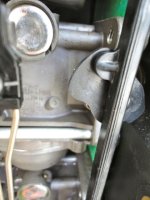I have removed all of the old fuel from the tanks, and put in new fuel. When the engine was shut down, the oils were changed, and carburetors drained. The tanks had 2 gallons on the port and 6 gallons on the starboard tanks. This was treated with Stabil and Startron--but it smelled stale, so discarded. As I was priming the carburetors, I noted fuel leaking from under the cowling. On examination, the fuel was coming from around the dime sized disc on the upper part of the carb:

The silver disc in the upper left corner. First any idea what this is, and why it is leaking? (Pressure relief?)
The engine was put up a little over a year ago, and running well then. I did kick it over, for a couple of turns (less than a second) and it appears that fuel is coming from under or around this disc.
I didn't find the exact part on the internet, but may have missed it somewhere.
Thanks!

The silver disc in the upper left corner. First any idea what this is, and why it is leaking? (Pressure relief?)
The engine was put up a little over a year ago, and running well then. I did kick it over, for a couple of turns (less than a second) and it appears that fuel is coming from under or around this disc.
I didn't find the exact part on the internet, but may have missed it somewhere.
Thanks!
